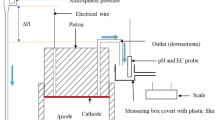Abstract
Application of electric currents through saturated silt and clay-rich soils induces electrochemical effects that influence the mechanical and hydraulic behaviour of soft soils. The transient effects of electro- and geo-chemical changes on pore pressure evolution in soil are poorly understood. A major issue, the transient development of non-linear geo- and physico-chemical conditions between the electrodes, is evaluated in this study. An experimental investigation was conducted to provide an understanding of the mechanisms that affect pore pressure or suction development along the sample and consequent transient and non-linear changes. A natural silty soil was used because it accounts for the complex physical and chemical interactions that originate during treatment in the field. Tests were conducted with free drainage at the boundaries and under constant current intensity. The experimental investigation results highlighted the importance of the boundary chemical conditions on the development and transient changes in excess pore pressure along the sample. In particular, the generation of high potential gradients in the first few millimetres of the soil sample dominates the overall pore pressure distribution and behaviour. A relationship between the maximum pore pressure developed and the applied current density is evaluated.








Similar content being viewed by others
References
Casagrande L (1949) Géotechnique 1:159
Shapiro AP, Renaud PC, Probstein RF (1989) PhysicoChemical Hydrodyn 11:785
Acar YB, Alshawabkeh AN (1993) Environ Sci Technol 27:2638
Lageman R (1993) Environ Sci Technol 27:2648
Probstein RF, Hicks RE (1993) Science 260:498
Yeung AT, Datla S (1995) Can Geotech J 32:569
Acar YB, Gale RJ, Alshawabkeh AN, Marks RE, Puppala S, Bricka M, Parker R (1995) J Hazard Mater 40:171
Acar YB, Alshawabkeh AN (1996) J Geotech Eng 123:173
Alshawabkeh AN, Yeung AT, Bricka MR (1999) J Environ Eng 125:27
Lageman R, Clarke RL, Pool W (2005) Eng Geol 77:191
Gray DH, Mitchell JK (1967) J Soil Mech Found Div 93:209
Esrig MI (1968) J Soil Mech Found Div 94:899
Wan T, Mitchell JK (1976) J Geotech Eng Div 102:473
Casagrande L (1983) J Boston Soc Civ Eng 55:171
Bjerrum L, Moum J, Eide O (1967) Géotechnique 17:214
Sutton J, Alexander E (1987) Geotechnical special publication N 12. Joseph P. Welsh, New York
Hunter RJ, Wright HJL (1971) J Colloid Interface Sci 37:564
O’Brien RW (1986) J Colloid Interface Sci 110:477
Eykholt GR (1997) J Hazard Mater 55:171
Alshawabkeh AN, Sheahan TC, Wu X (2004) Mech Mater 36:453
Mise T (1961) Proc 5th int conf on soil mechanics and foundation engineering 1:255
Gabrieli L, Jommi C, Musso G, Romero E (2008) J Appl Electrochem 38:1043
Eykholt GR, Daniel DE (1994) J Geotech Eng 120:797
Ladd RS (1978) Geotech Test J 1:16
Gabrieli L, Jommi C, Musso G, Romero E (2008) In: Shao JF, Burlion N (eds) Thermo-hydromechanical and chemical coupling in geomaterials and applications: Proceedings of the 3rd international symposium GeoProc2008. Wiley, ISTE, pp 203-210
Author information
Authors and Affiliations
Corresponding author
Rights and permissions
About this article
Cite this article
Gabrieli, L., Alshawabkeh, A.N. Influence of boundary conditions on transient excess pore pressure during electrokinetic applications in soils. J Appl Electrochem 40, 1113–1121 (2010). https://doi.org/10.1007/s10800-010-0075-0
Received:
Accepted:
Published:
Issue Date:
DOI: https://doi.org/10.1007/s10800-010-0075-0




